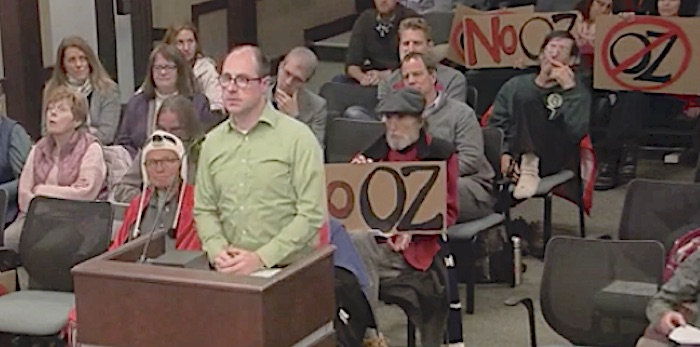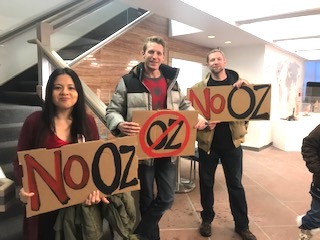On a cold night, Council green-lights Opportunity Zone
Leora Frankel | Nov 2, 2019

On Tuesday, October 29, at the final pre-election meeting of the sitting Boulder City Council, a moratorium on developments in the Opportunity Zone was lifted in a 7-1 vote, with only Council Member Cindy Carlisle dissenting. Consequently, the City will start accepting new development plans Dec. 2 for projects in the 2.5-square-mile OZ area, which stretches from 28th Street to 55th Street and from the Diagonal Highway to Arapahoe Avenue.
In the five preceding days, Council had received emails from over 100 people requesting an extension of the moratorium. The emails came steadily, expressing dismay at the very existence of the Opportunity Zone — which hitherto had received scant public attention — and at the lack of an impacts report. This flow of opposition dominated citizen input to the Council during that period. Council received only two emails requesting that the moratorium be lifted, one coming from the Boulder Chamber.
Brenda Lyle, Executive Director of the Family Learning Center, which is situated in the Opportunity Zone, wrote: “So you all were elected to serve all the people. Can you guarantee our poor and our often most racially diverse children and families will not be adversely affected by removing the ban?” A resident of the Vista Village mobile home community wrote: “The prospect of being forced to sell my home because I can’t keep up with ever larger rent increases is one concern.”

For background on the federal Opportunity Zone tax break, and to understand how a part of Boulder that includes both Google and Whole Foods became an Opportunity Zone, see my recent story.
Cold night, small attendance
That night the temperature at 6 p.m. was 10 degrees. A winter storm had caused the early closure of City offices. Nevertheless, Council held its special meeting, which included a send-off for Council Members Lisa Morzel, Suzanne Jones and Carlisle. Between 25 and 30 residents were in attendance at the meeting demanding that the moratorium remain in place. Some held cardboard signs, with “No OZ” painted on them. Three candidates running in the City Council election on Tuesday, Nov. 5, took part in a brief pre-meeting rally in the Municipal Building: Corina Julca (who lives in the Opportunity Zone), Brian Dolan and Adam Swetlik.
NOTE: Opposition organizers have announced a community forum for further discussion of the Opportunity Zone to be held Sunday, Nov. 10, 4:30 p.m. to 6:00 p.m, in the Boulder Public Library Main Branch, Boulder Creek Room.
The atmosphere in the Council chamber was incongruent, as the protesters made up about half of the public and were not in a celebratory mood when accolades were heaped on the departing Council members. The Council’s usual live-streaming via municipal Channel 8 and the internet failed, possibly because of an earlier power outage.
The Opportunity Zone ordinances were Item 2N on what is called a “consent agenda.” This procedure allows Council to hold one vote for a bucket list of items. If a Council member believes an item merits special attention, they can call it up, try to get it seconded, and demand a separate vote on this piece of legislation. This didn’t happen. Instead Council discussed the Opportunity Zone, and moved on to the next item.
That discussion focused on what Council members referred to as “protections” that will, according to them, ensure that development in the Opportunity Zone matches the goals of the Boulder Valley Comprehensive Plan. The primary protections mentioned were the existing height moratorium, the revised use tables, the overlay zone to prevent demolition of multi-family housing, the increase in linkage fees starting on Jan. 1, and the low floor-to-area ratio in the industrial zones. Council Member Mary Young asked Interim Planning Director Chris Meschuk to explain to the public why those tools were adequate.
Are they, indeed, adequate?
Since no opposing opinions were raised that night – it was like a trial in which only the defense gets to talk – I will point out that the information provided was partial, ad-hoc, not quantitative and was in no way a substitute for a report hundreds of pages long laying out the impacts of the Opportunity Zone designation.
Impact on current occupants
At no point in the preceding almost year-long process did Council instruct staff to project how these new massive tax incentives would reshape the lives of thousands of residents. The emphasis was predominantly on the types of uses that would be allowed for new structures, not on how the occupants, residential and commercial, will likely experience the changes in the form of increased rents, skyrocketing property taxes, demolished buildings, upgraded and newly unaffordable buildings and diminishing options.
There has been a stubborn refusal on the part of Boulder’s governing body to consider that within the OZ the calculation of profitability is markedly different from that in the rest of the city, and that this difference will likely result in accelerated gentrification.
The protections described do not prevent one-story buildings in business zones from being replaced with three-story buildings. Or old three-story buildings giving way to new three-story buildings. They allow for a tripling of office space from the current median of just under 6,000 square feet per building to 20,000 square feet per building. When Council Member Young commented that leases in the mobile home parks may extend from month-to-month to year-long as a result of new regulations, it is doubtful many residents found this sufficiently reassuring.
The issues involved in the Opportunity Zone are complex and not easy to digest, which is one reason people only awakened to its existence and its ramifications at the very last minute.
Questions by two Council members
Council members Mirabai Nagle and Carlisle proposed extending the moratorium. Nagle said she wanted “community buy-in” on the Opportunity Zone. However, Council member Aaron Brockett stood steadfast in his insistence that the “the harm of additional time on the moratorium is the small business owners that aren’t able to move forward with the plans they’ve had for over a year.” Meschuk could not quantify how many property or business owners have been unable to start new development because of the moratorium. Council member Sam Weaver said he knew of “a couple,” and confirmed that the inability to get a permit was “the biggest risk in not moving forward.”
Mayor Suzanne Jones was eager to move on to the next item, now that the public had been made aware that what she deemed the necessary work had been performed by Council and City staff.
For some Council members, the information presented that night was new. Carlisle said: “We have gotten so much information in just sitting here this evening right now that hasn’t been available to me.” Young explained that she had learned a lot over the last few days “through poking around with questions.”
Interestingly, most of the information Meschuk shared had been available for months. You just had to want to — or have the time to — find it. Genuinely new data will not be forthcoming, since it was never requested by Council.
(Results of the current Council election, in which six of nine Council seats are up for grabs, were to be announced Tuesday evening, Nov. 5.)
(NOTE: When journalists approach an issue, they should have an open mind and follow the facts. This is the route I took. But by the end of my journalist’s journey, when I finally sat down to write, I had definitely formed an opinion. I’ve made no attempt to conceal my activism against what I view as a massive tax giveaway to investors at the expense of people living in, or managing small businesses, in the OZ. – L.F.)


Thank you for approaching reporting with an unbiased journalistic creed. It’s why readers respect and believe in news reporters. The personal opinion shared at the end of the article makes their reporting even more legitimate.
About the Opportunity Zone, as you reported, all the moneyed interests, the politicians, investors, and businesses will win the fight. It’s real like gravity. Poor people and communities don’t have the staying power and the power of moral and compassionate force rarely can fight and sustain the battle with financial and political interests.
In the long run, an Opportunity Zone will bring more money into the community even if it is at the expense of more hardship for the poor. It is the nature of the democracy we have created. In a country of abundance, Boulder is a among the richer communities. Yet we show little compassion to our poor and struggling brothers and sisters.
It’s why we should listen and follow the moves in the city council that is shaping our community today and redefining it for the future.
Excellent article. Really lays everything out. I was at the city council meeting when they voted to lift the moratorium… I was upset then. After reading your article and the one you cited about Google and Whole Foods, I’m even more upset. Hard to believe that this vote was the last thing they do as they leave office. Disgraceful. I am a very very concerned and unhappy Boulder resident. Thank you so much for staying on this story. Madeline